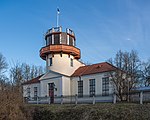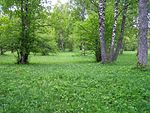List of World Heritage Sites in Estonia
The United Nations Educational, Scientific and Cultural Organization (UNESCO) World Heritage Sites are places of importance to cultural or natural heritage as described in the UNESCO World Heritage Convention, established in 1972.[1] Estonia accepted the convention on 27 October 1995, making its historical sites eligible for inclusion on the list. The first site added to the list was the Historic Centre (Old Town) of Tallinn, in 1997. The second site, the Struve Geodetic Arc, was added in 2005. This is a transnational site and is shared with nine other countries.[2] Both sites are cultural sites.[2] In addition to its World Heritage Sites, Estonia also maintains three properties on its tentative list.[2]
World Heritage Sites
[edit]UNESCO lists sites under ten criteria; each entry must meet at least one of the criteria. Criteria i through vi are cultural, and vii through x are natural.[3]
| Site | Image | Location | Year listed | UNESCO data | Description |
|---|---|---|---|---|---|
| Historic Centre (Old Town) of Tallinn | 
|
Tallinn | 1997 | 822; ii, iv (cultural) | The historic centre of Tallinn is an outstanding example of a medieval northern European trading city. The city started around the 13th century castle built by the knights of the Teutonic Order. From the 13th to the 16th century the city was an important centre of the Hanseatic League, being one of the most remote outposts of the League. Hanseatic Tallinn was a wealthy city, which is demonstrated by its opulent public buildings, including churches, the Town Hall, and the merchant's houses. The Walls of Tallinn, built in the 13th century, are still largely extant today.[4] |
| Struve Geodetic Arc* | 
|
Väike-Maarja Parish, Tartu | 2005 | 1187, ii, iii, vi (cultural) |
The Struve Geodetic Arc is a series of triangulation points, stretching over a distance of 2,820 kilometres (1,750 mi) from Hammerfest in Norway to the Black Sea. The points were set up in a survey by the astronomer Friedrich Georg Wilhelm Struve who first carried out an accurate measurement of a long segment of a meridian – and along with it the size and shape of the Earth. Originally, there were 265 station points. The World Heritage Site includes 34 points in ten countries (north to south: Norway, Sweden, Finland, Russia, Estonia, Latvia, Lithuania, Belarus, Moldova, Ukraine), three of which are in Estonia. The University of Tartu Old Observatory is pictured.[5] |
Tentative list
[edit]In addition to sites inscribed on the World Heritage List, member states can maintain a list of tentative sites that they may consider for nomination. Nominations for the World Heritage List are only accepted if the site was previously listed on the tentative list.[6] As of 2019, Estonia lists three properties on its tentative list.[2]
| Site | Image | Location | Year listed | UNESCO criteria | Description |
|---|---|---|---|---|---|
| Kuressaare Fortress | 
|
Kuressaare | 2002 | iv (cultural) | Kuressaare Castle was first mentioned in 1381. It was built for the bishop in Late Gothic style. Between the 15th and 17th centuries, the surrounding fortifications were added, some of which were later removed and some restored in the 20th century. Today, the castle is the most popular tourist destination on Saaremaa Island. The town park is a nature reserve with many plant species.[7] |
| Baltic Klint | 
|
Western Estonia | 2004 | vii, viii, ix, x (natural) | The Baltic Klint is a limestone escarpment, 250 kilometres (160 mi) of its length is in Estonia. The escarpment exposes sedimentary rocks up to 500 million years old, that have been undamaged by tectonic processes and contain an abundance of well-preserved fossils. They serveas a valuable basis for compilation of Cambrian and Ordovician regional and local stratigraphical classification.[8] |
| Wooded meadows (Laelatu, Kalli-Nedrema, Mäepea, Allika, Tagamõisa, Loode, Koiva, Halliste) | 
|
Eight sites | 2004 | (mixed) | The wooded meadows are sparse wooden areas that are regularly mowed or grazed. They are similar to parks but have existed for millennia, and they have been crucial in supporting animal husbandry. Eight representative meadows are selected in this nomination.[9] |
References
[edit]- ^ "The World Heritage Convention". UNESCO World Heritage Centre. Archived from the original on 27 August 2016. Retrieved 21 September 2010.
- ^ a b c d "Estonia". UNESCO World Heritage Centre. Archived from the original on 24 November 2019. Retrieved 24 November 2019.
- ^ "UNESCO World Heritage Centre – The Criteria for Selection". UNESCO World Heritage Centre. Archived from the original on 12 June 2016. Retrieved 17 August 2018.
- ^ "Historic Centre (Old Town) of Tallinn – UNESCO World Heritage Centre". UNESCO World Heritage Centre. Archived from the original on 5 January 2020. Retrieved 28 December 2019.
- ^ "Struve Geodetic Arc". UNESCO World Heritage Centre. Archived from the original on 18 October 2011. Retrieved 20 October 2011.
- ^ "Tentative Lists". UNESCO World Heritage Centre. Archived from the original on 1 April 2016. Retrieved 7 October 2010.
- ^ "Kuressaare Fortress". UNESCO World Heritage Centre. Archived from the original on 29 December 2019. Retrieved 28 December 2019.
- ^ "Baltic Klint". UNESCO World Heritage Centre. Archived from the original on 29 December 2019. Retrieved 28 December 2019.
- ^ "Wooded meadows (Laelatu, Kalli-Nedrema, Mäepea, Allika, Tagamoisa, Loode, Koiva, Halliste)". UNESCO World Heritage Centre. Archived from the original on 29 December 2019. Retrieved 28 December 2019.


